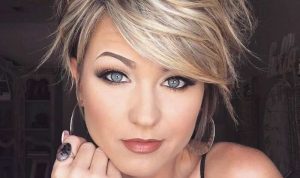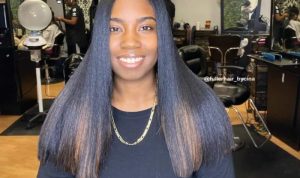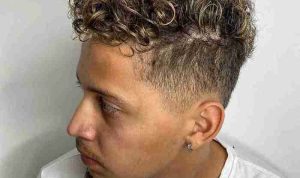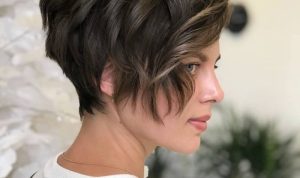Popular Medium Length Hairstyles for Thick Hair
Medium length hairstyles thick hair – Medium-length hairstyles offer a versatile and stylish option for those with thick hair. They allow for a balance between manageability and the ability to showcase the hair’s volume and texture. This section explores several popular choices, detailing their styling techniques, pros and cons, and suitability for different face shapes and hair textures.
Popular Medium-Length Hairstyles
Here are five popular medium-length hairstyles suitable for thick hair, along with styling tips and considerations for different face shapes:
| Style | Description | Styling Tips | Ideal Face Shapes |
|---|---|---|---|
| Long Bob (Lob) | A classic, versatile cut that falls just below the chin or at the collarbone. Often features subtle layers for movement. | Use a round brush and hairdryer for a sleek look, or air dry for a more natural texture. Texturizing sprays can add volume and definition. | Oval, round, square |
| Layered Lob | Similar to a classic lob, but incorporates layers throughout for added volume and movement, particularly beneficial for thick hair. | Apply mousse or volumizing spray before blow-drying to enhance the layers. Use a curling iron for added waves or curls. | Oval, heart, square |
| Clavicle-Length Shag | A textured, layered style with choppy ends that creates a carefree, effortless vibe. | Use texturizing products like sea salt spray or dry shampoo for a tousled look. Air drying is ideal. | Oval, heart, square |
| Blunt Cut | A bold, geometric cut with a straight, even line at the ends. Can be styled sleek and straight or with soft waves. | Requires regular trims to maintain the sharp line. Use a flat iron for a sleek finish. | Oval, square |
| Inversion Bob | A bob with shorter layers at the crown and longer layers towards the ends, creating volume and movement. | Blow-dry with a round brush, focusing on lifting the roots for added volume. Use a curling iron to add soft waves to the ends. | Oval, round, heart |
The pros and cons of each style vary depending on individual hair texture and lifestyle. For example, a blunt cut might require more frequent trims but offers a sleek, modern look, while a shag requires less maintenance but might not suit all hair textures within the “thick hair” category. A layered lob offers a good balance of volume and manageability, working well with most thick hair types.
Three Looks from One Base Haircut
The versatility of a medium-length haircut, such as a layered lob, can be demonstrated through different styling techniques. Let’s imagine a base haircut of a shoulder-length layered lob.
- Look 1: Sleek and Straight: This look is achieved using a flat iron after applying a heat protectant. The result is a polished and sophisticated style.
- Look 2: Beachy Waves: A texturizing spray and a curling iron (or even a braid overnight) can create relaxed, beachy waves. This style offers a casual, effortless vibe.
- Look 3: Polished Curls: Using a larger barrel curling iron and setting spray creates defined, voluminous curls. This is a more formal and elegant look.
Hairstyle Considerations Based on Face Shape
Choosing a medium-length hairstyle should consider face shape to complement features and create a balanced look. Thick hair presents unique challenges and opportunities in this regard.
Suitable Hairstyles for Different Face Shapes, Medium length hairstyles thick hair
- Round Face: Long layers and side-swept bangs can help elongate the face. Avoid blunt cuts that emphasize roundness. A layered lob with subtle waves can be flattering.
- Oval Face: Most medium-length styles suit oval faces, offering considerable versatility. A blunt bob, a layered lob, or even a shag can all look great.
- Square Face: Soften the strong angles with long layers and side-swept bangs. Avoid styles that are too blunt or heavy at the jawline. A layered lob or a clavicle-length shag can help balance the features.
- Heart Face: Styles that add volume at the bottom, such as a layered lob or a long bob with subtle layers, balance the wider forehead. Avoid styles that are too short or that emphasize the pointed chin.
Hair color can also subtly alter the perceived shape of the face. Darker colors can make features appear sharper, while lighter colors can soften them. This should be considered when choosing a style and color combination.
Styling and Maintenance Techniques: Medium Length Hairstyles Thick Hair
Managing thick, medium-length hair requires specific techniques and products to maintain health, shine, and desired styles.
Managing Frizz and Volume
- Method 1: Smoothing Serum and Blow-dry: Apply a smoothing serum to damp hair before blow-drying with a round brush. This helps to control frizz and add shine.
- Method 2: Deep Conditioning Treatment: Regularly use a deep conditioning treatment to hydrate and smooth the hair cuticle, reducing frizz. This should be done at least once a week.
- Method 3: Anti-Frizz Products: Incorporate anti-frizz products, such as leave-in conditioners or serums, into your routine. These help to seal the hair cuticle and prevent moisture loss.
Everyday Styling Techniques
- Quick Blow-dry: Use a round brush to quickly dry and style the hair, adding volume at the roots.
- Textured Waves with Braid: Braid damp hair overnight for natural waves the next morning.
- Half-updo: A simple half-updo is a quick and easy way to style thick hair, especially when time is limited.
- Low Ponytail: A sleek low ponytail is both chic and practical.
- Headband Style: A headband can add a touch of elegance and keep hair out of the face.
Maintaining Healthy Hair
Washing, conditioning, and product use are crucial for maintaining the health and shine of thick hair. Avoid over-washing, which can strip the hair of its natural oils. Use a moisturizing conditioner after every wash, and consider a deep conditioning treatment once a week. Choose products specifically formulated for thick hair to manage volume and prevent dryness.
Managing medium length hairstyles for thick hair often involves finding ways to reduce bulk and add movement. Conversely, those with thin hair might benefit from the volume created by techniques used in long layered hairstyles for thin hair. Understanding these contrasting approaches helps stylists tailor cuts to individual hair types, ultimately leading to more manageable and stylish results for medium length thick hair.
Addressing Specific Hair Concerns
Individuals with thick, medium-length hair often face specific challenges. Understanding these and implementing preventative measures is crucial for healthy, manageable hair.
Common Challenges and Solutions
- Excessive Volume: Use weightless styling products and consider regular layering to distribute weight evenly. Avoid products that add extra volume.
- Difficulty in Styling: Regular trims and using the right tools (such as a good quality round brush and hairdryer) can make styling easier. Consider using styling creams or mousses to provide hold and control.
- Split Ends: Regular trims are essential to prevent split ends. Use hair masks and conditioners to keep the hair hydrated and prevent breakage.
- Uneven Layers: Addressing uneven layers requires a professional haircut. Trying to fix them at home could worsen the issue.
- Difficulty Achieving a Sleek Look: Use a flat iron or straightening brush and apply a heat protectant before styling. Use a smoothing serum to help control frizz.
Hair Accessories and Styling Tools
The right tools and accessories can significantly simplify the styling process for thick, medium-length hair. Investing in quality items can make a big difference.
Essential Accessories and Tools
- Round Brush: Essential for blow-drying and adding volume and shape.
- Wide-Tooth Comb: Gently detangles thick hair without causing breakage.
- Hair Clips: Useful for sectioning hair during styling and creating various updos.
- Hair Ties: Choose gentle hair ties that don’t pull or damage the hair.
- Heat Protectant Spray: Essential for protecting hair from heat damage when using hot styling tools.
Choosing the right hairbrush depends on hair thickness and desired style. A wide-tooth comb is best for detangling, while a round brush is ideal for blow-drying and adding volume. For sleek styles, a paddle brush might be preferable.
Top FAQs
How often should I wash thick hair?
Washing frequency depends on your hair’s oil production, but generally, every other day or every two to three days is recommended to avoid over-drying.
What’s the best way to detangle thick hair?
Start from the ends and work your way up, using a wide-tooth comb or a detangling brush to minimize breakage. Apply a leave-in conditioner for easier detangling.
Are there specific products for thick, frizzy hair?
Yes, look for products labeled “smoothing,” “anti-frizz,” or “volumizing” depending on your desired outcome. Serums and smoothing creams are particularly helpful.
Can I use heat styling tools every day?
Frequent heat styling can damage your hair. Use heat protectant sprays and limit use to a few times a week, if possible. Air drying is always a healthier option.






